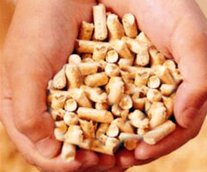corn pellets
Corn pellets are fuel pellets made from corn (maize) for use in corn pellet stoves. Burning shelled corn produces about the same amount of heat as wood pellets (8,000 BTU/lb.) but results in more ash, so the maintenance on the pellet stove in terms of ash removal is greater. On the plus side, corn pellets are generally cheaper than wood pellets, though this depends a great deal on where you live. They can be bought at feed stores or directly from a farmer for as little as $2.50 per bushel (a bushel of shelled corn weighs 56 lb.). Combined with the high efficiency of corn, up to 82 percent, corn heaters can be one of the cheapest ways of heating a home. When deciding whether or not to heat your home by this method, however, it's vital to check on the availability and pricing of corn in your area. In the breadbasket states of the US, for example, you may be able to load up a ton of corn at a local grain elevator at very low cost, especially if you're willing to spend the time to dehusk and dry the corn yourself. In other areas, such as the New England states, where the corn has to be brought in, the cost may be several times as great. In any case, the cost will vary from year to year depending on the crop.
 |
The annual cost of heating with corn fuel depends on many factors. One user in the Great Lakes region, for example, quotes heating a 2,000 sq. ft. home (with good circulation and insulation) using 150 to 200 bushels in a 60,000 BTU unit. (One BTU is the amount of heat needed to raise one pound of water one degree.)
Like wood pellets, corn pellets come from a renewable source, which, together with their clean burning, makes them eco-friendly. As a nice additional bonus, burning corn creates a wonderful sweet scent outdoors.
Comparison of corn with other fuels
Column 4 gives a measure of the approximate cost of heat available from each alternative source of fuel. However, column 5 is the key column, as it incorporates the efficiency of a particular unit to ensure the effective cost of that energy for heating your home.
Typically, it takes 30 to 40 pounds of corn per day to heat a 1500 square foot home. This means that you can heat your home for an average of $1.64 per day.
Even within a state, average energy or fuel prices can vary widely. So, to determine the specific cost comparisons in a particular region or country you need to change the price structure in Column 3, to determine the resulting costs on Column 4 and 5. Similarly, different efficiency levels can be substituted in Column 5 to allow flexibility to test various heating units.
| Prices may vary according to location | BTU value/unit | Units required to produce 1,000,000 BTU | Fuel price/unit (approximate) | Total cost to produce 1,000,000 BTU | Effective cost to produce 1,000,000 BTU |
| Dry shelled corn | 8,500/pound 7,500/pound | 118/lb.=2 bu 133/lb.=2.4 bu | $1.75/bushel $2.30/bushel $2.85/bushel | $3.50 $4.60 $6.84 | @85% efficiency = $4.12 - $5.41 - $8.05 |
| Electricity | 3,413/KWH | 293 KWH | 9 cents/KWH 5 cents/KWH | $26.37 $14.65 | @100% efficiency = $26.37 & $14.65 |
| Natural gas | 1,000/cubic feet | 1,030 cubic feet | $2.00/100 cf $1.00/100 cf | $20.60 $10.30 | @85% efficiency = $24.25 & $12.10 |
| Fuel oil | 139,000/gallon | 7.1 gallons | $2.25/gallon $1.15/gallon | $16.00 $8.17 | @80% efficiency = $18.80 & $9.60 |
| LP gas | 91,690/gallon | 11 gallons | $1.85/gallon $.65/gallon | $20.35 $7.15 | @80% efficiency = $25.44 & $8.94 |
| Wood | 16,464,000/cord | .0607 cords | $185.00/cord $100.00/cord | $11.23 $6.07 | @75% efficiency = $15.00 & $8.00 |
| Wood pellets | 8,000/pound | 125 lbs .06 tons | $185.00/ton $145.00/ton | $11.56 $8.70 | @87% efficiency = $13.29 & $10.00 |
Now let's compare corn to other fuel sources. An average home will burn 85 to 150 bushels of corn a season, depending on the temperature, size of home, insulation and placement of unit.
| 1 bushel of shelled corn | = | 5.0 gallons of LP gas |
| = | 3.5 gallons of fuel oil | |
| = | 140 kilowatt hours of electricity | |
| = | 4.75 C.C.F. of natural gas |
Storage
Storage of corn pellets can be problematic, especially if you're not in a rural area. The most economic way to buy corn is in bulk but then you need something like a spare garage to hold it in. If you plan to store corn inside your home then be sure to use tight storage containers, clean up corn spills straight away, and avoid storing corn for long periods, otherwise you may have a problem with rodents and stored grain insects.
Burning corn pellets in a wood pellet stove?
Whether you can successfully burn corn pellets or other biomass material in your pellet stove depends on the make and model you have, so consult your dealer first. When burning corn in a wood pellet stove it's best to use a 50/50 mixture of wood pellets and corn. One of the problems you'll run into is clinkers. When the sugars in corn burn they leave behind a hard residue in the burner. This means you'll have to clean the stove more often. Most corn stoves have a mechanism for automatically clearing out clinkers. Another option is a multi-fuel pellet fuel that's designed to burn a variety of fuels including wood, corn, cherry pits, and so on. Some corn stoves, such as the popular Dansons Group Cheap Charlie Model HCCC2GD are also specifically built to efficiently burn wood pellets as well.
